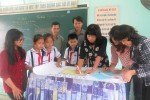Winter-Spring Crop Model coping with climate change in Ba To district, Quang Ngai province
In the morning of 19 April 2013 at Con Ra village, Ba Bich commune, Ba To district, Quang Ngai province, local residents and leaders undertook harvesting and evaluating the effectiveness of the model “Growing Winter-Spring Crop mitigation the effects of cold in the seedling stage, and cold and frost in the flowering stage” with joy and excitement. The model was funded by Plan International in Vietnam and technical guidance was provided the by the Center for Rural Development in Central Vietnam (CRD), Hue University of Agriculture and Forestry. This is one of the activities within the framework of the project “Child-centered Climate Change Adaptation” in Ba To district, Quang Ngai province.
The main purpose of the model is the application of appropriate farming techniques (determine the appropriate calendar, use good varieties and take care by suitable techniques) to promote rice to grow well in the seedling stage to avoid cold and frost in the flowering stage. It helps increase rice yield in the winter-spring crop. The project has supported the farmers with agricultural materials, training and technical guidance. During the four months of implementation, knowledge on seed selection, calendar determination, weeding, caring, watering, detection and effective disease prevention has been supported continuously.
Despite facing many difficulties in the process of implementing the model, e.g., prolonged cold and frost, people are not familiar with technical application in rice cultivation. Methods of growing rice adapting to climate change has been too difficult to understand for the locals. However, good organization, management and implementation mobilized the active participation of people who now understand and comply with the requirements of the project to minimize the risk of the adverse weather conditions.
After four months of implementation, people know how to classify and use varieties, to keep varieties, weed, feed fertilizer properly and use irrigation water efficiently, and the work of combating rats has also been transferred successfully. Mr. Pham Van Dot, team leader of the model told us, “The model helped us understand the effectiveness of technical application in rice cultivation. Applying techniques brought the real effectiveness beyond our expectations. Rice yields were estimated at 2.5-3 quintal per sao”, he added “Application of new varieties (KD18) brought out higher yields by 50-60% compared to the old ones, strong and healthy rice resistance to pests and diseases. The proper use of irrigation water is more effective during droughts and increased the efficiency of fertilizer. Application of nylon prevented the disturbance of rats better than before”. According to Mr. Pham Van Kem, head village of Con Ro, the model showed new or good ideas compared to the previous thinking. The previous models only cared about productivity and pay less attention to prevention techniques under the adverse weather conditions. He said, “people following the model learned that their paddy fields have less grass and diseases and they no longer worry about the disturbance of rats and gain more rice, …”
During the coordination and direction during the implementation of the model, project officers and local officers learned valuable lessons in directing and guiding the implementation of production activities. According to Mrs. Le Thi Tram, vice president of Ba Bich CPC, the enthusiastic and responsible support of project officers not only helped households who implemented the model grow rice well but also improves qualifications and technical transfer method of communal agriculture officers in the context of adverse weather and climate change. Mrs. Tram recommends that the project continue to support the summer-autumn crop so that other people in other villages also can benefit.
After overcoming the initial difficulties, the results obtained from the model are very good. Villagers and local authorities are happy that the project had appropriate approach methods and brought high efficiency to rice production in their locality. On behalf of beneficiaries, Mr. Pham Van Dot emotionally gives thanks for the help of Plan International, Center for Rural Development in Central Vietnam and authorities at all levels for facilitating his group to have such a good harvest as today. Mr. Dot as well as the group commit to continue sharing knowledge and experience in the process of implementing the model with other people in the community and expects that the project will continue providing technical assistance in the next crop to the group and people not currently received the benefits.
Not only the model in Ba Bich commune but also other models in Ba Dinh, Ba To and Ba Xa communes have achieved good results and people also have the same comments and thoughts as Ba Bich commune. With this initial success, it is hopefully that people and local authorities will continue to maintain, share and replicate the project achievements to other households in the villages and communes. Groups of households directly implementing the model in Winter-Spring crop will be the important nucleus for other people to visit and learn. From that, the activity of growing rice in this locality is increasingly effective and adapts well to the context of climate change.
Do Cao Anh and Phan Cong Tam
Center for Rural Development in Central Vietnam
Some pictures of harvesting rice models

 |
 |
 |
 |
 |
 |





